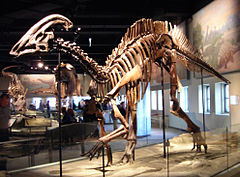
Hadrosaurids, also commonly referred to as duck-billed dinosaurs or hadrosaurs, were large terrestrial herbivores. The diet of hadrosaurid dinosaurs remains a subject of debate among paleontologists, especially regarding whether hadrosaurids were grazers who fed on vegetation close to the ground, or browsers who ate higher-growing leaves and twigs. Preserved stomach content findings have indicated they may have been browsers, whereas other studies into jaw movements indicate they may have been grazers.
The mouth of a hadrosaur had hundreds of tiny teeth packed into dental batteries. These teeth were continually replaced with new teeth.[1] Hadrosaur beaks were used to cut food, either by stripping off leaves[2][3] or by cropping.[1] It is believed hadrosaurs had cheeks in order to keep food in the mouth.[4][5]
Researchers have long believed their unusual mouth mechanics may have played a role in their evolutionary success.[6] However, because they lack the complex flexible lower jaw joint of today's mammals, it has been difficult for scientists to determine exactly how the hadrosaurs broke down their food and ate.[7] Without this understanding, it had been impossible to form a complete understanding of the Late Cretaceous ecosystems and how they were affected during the Cretaceous–Paleogene extinction event 66 million years ago.[8] It has also remained unclear exactly what hadrosaurids ate. In particular, it has never been definitively proven whether hadrosaurs were grazers who ate vegetation close to the ground, like modern-day sheep or cows, or whether the dinosaurs were browsers who ate higher-growing leaves and twigs, like today's deer or giraffes.[8]
A 2008–2009 study by University of Leicester researchers analyzed hundreds of microscopic scratches on the teeth of a fossilized Edmontosaurus jaw and determined hadrosaurs had a unique way of eating unlike any creature living today. In contrast to a flexible lower jaw joint prevalent in today's mammals, a hadrosaur had a unique hinge between the upper jaws and the rest of its skull. The team found the dinosaur's upper jaws pushed outwards and sideways while chewing, as the lower jaw slid against the upper teeth.
Coprolites (fossilized droppings) of some Late Cretaceous hadrosaurs show that the animals sometimes deliberately ate rotting wood. Wood itself is not nutritious, but decomposing wood would have contained fungi, decomposed wood material and detritus-eating invertebrates, all of which would have been nutritious.[9]
- ^ a b Horner, John R.; Weishampel, David B.; Forster, Catherine A. (2004). "Hadrosauridae". In Weishampel, David B.; Dodson, Peter; Osmólska Halszka (eds.). The Dinosauria (2nd ed.). Berkeley: University of California Press. pp. 438–463. ISBN 0-520-24209-2.
- ^ Ostrom, John H. (1964). "A reconsideration of the paleoecology of the hadrosaurian dinosaurs". American Journal of Science. 262 (8): 975–997. Bibcode:1964AmJS..262..975O. doi:10.2475/ajs.262.8.975.
- ^ Galton, Peter M. (1970). "The posture of hadrosaurian dinosaurs". Journal of Paleontology. 44 (3): 464–473.
- ^ Galton, Peter M. (1973). "The cheeks of ornithischian dinosaurs". Lethaia. 6 (1): 67–89. doi:10.1111/j.1502-3931.1973.tb00873.x.
- ^ Fastovsky, D.E; Smith, J.B (2004). "Dinosaur paleoecology". The Dinosauria. Berkeley: University of California Press. pp. 614–626. ISBN 0-520-24209-2.
- ^ Strickland, Eliza (2009-06-30). "Duck-Billed Dinosaur's Shifting Teeth Were Like a "Cranial Cuisinart"". Discover. Archived from the original on 2010-12-19. Retrieved 2009-07-03.
- ^ "Hadrosaur chowdown — grind, grind, grind". Associated Press. 2009-06-29.
- ^ a b Boyle, Alan (2009-06-29). "How dinosaurs chewed". MSNBC. Archived from the original on 2009-07-02. Retrieved 2009-07-03.
- ^ Chin, K. (September 2007). "The Paleobiological Implications of Herbivorous Dinosaur Coprolites from the Upper Cretaceous Two Medicine Formation of Montana: Why Eat Wood?". PALAIOS. 22 (5): 554–566. Bibcode:2007Palai..22..554C. doi:10.2110/palo.2006.p06-087r. S2CID 86197149. Retrieved 2008-09-10.